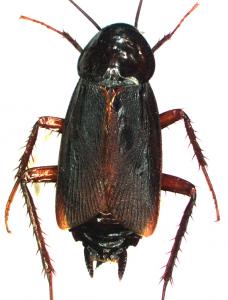Adult
Size
20 to 30 mm long
Aspect
Oval, dorso-ventrally flat body. Sturdy, rather long legs, tibiae with rows of spiny bristles.
Fine, moniliform antennae that can be longer than the body.
Very short elytra and stumped wings in females, whereas they cover ¾ of the body in males.
The two short cerci at the end of the abdomen have tactile hairs that are highly sensitive to sounds and vibrations, and enable oriental cockroaches to run away at the slightest noise.
Colour
Dark brown to nearly black, more or less shiny.
The pronotum is generally darker than the thorax, and the legs are hued with reddish brown.


 Blatte orientale, Blatte domestique, Blatte des cuisines, Cafard domestique
Blatte orientale, Blatte domestique, Blatte des cuisines, Cafard domestique  Oriental cockroach waterbug black beetle
Oriental cockroach waterbug black beetle  Cucaracha negra
Cucaracha negra  Orientalische Schabe Küchenschabe
Orientalische Schabe Küchenschabe 

